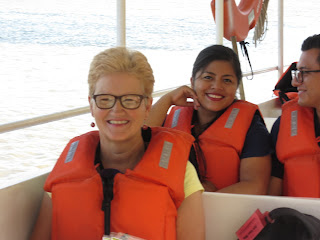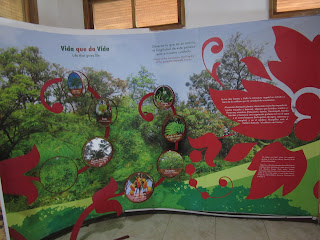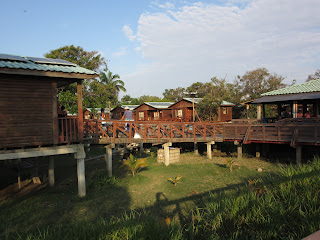After spending several hours at Guayaquil's Parque Historico on the other side of the Guayas River, we found a driver to take us to the Malecon, the charming riverside boardwalk that we'd enjoyed so much the previous afternoon.
Don't forget to click on any photo if you want to enlarge it.
This map gives you an idea of our day geographically. From Guayaquil on the left, we'd gone north to Parque Historico in Samborondon, then back to the city and from there the boat ride south to Islay Santay.
Views of Guayaquil's shoreline:
We didn’t realize when we bought the tickets that we hadn’t just purchased a boat ride but rather a guided tour of the island. The guided tour was entirely in Spanish which severely taxed our very limited knowledge of the language. As the guide spoke very quickly, we caught only limited snippets of her commentary.
The bungalows were available for rent for $30 a night. You may recall my mentioning many posts ago that the currency in Ecuador was dollars.
The island was connected by elevated, ecological-friendly trails made of recycled materials that would last about twenty years.
After the guide's introduction about Santay's history, we went to an interpretation center to learn about the island's flora and fauna and the eco-village. Santay was created as a national government initiative in 2011 with the lofty goal of establishing sustainable use of the island and 'benefiting 56 families consisting of 235 people.'
The reason tourists come to Santay is for its diverse ecological environment as characterized by its coastal fauna and flora. This protected wetlands area was recognized for the variety of interior freshwater and marine habitats where threatened migratory species converge.
The guide mentioned that there were 14,700 hectares of mangrove forests in Ecuador and tiny Islay Santay had five different mangrove forests.
I believe these were coffee beans growing but don't hold me to it!
The mangrove forests were important because different animals made their homes there.
The guide went on about these trees but we didn't understand her! You'll see more of them when I write about our time in the Amazon Basin area of Peru!
All I can say is thank goodness for a good telephoto lens and a steady hand! There were 85 species of birds on the island but we didn't know what these were.
Mammals such as the raccoon, the ocelot, the anteater and the bat inhabited the island. We only saw a couple of goats, though!
We learned that the eco-homes included a living room, a dining room, a kitchen, two bedrooms, potable water, a sanitary system and solar power.
The locals benefited from education, free medical care, a recycling center, a water treatment plant and a pier after Santay was made into an eco-village.
An unusual tree with the bark changing like that:
Views of the walkway and cycleway on our return in the late afternoon.
Don't forget to click on any photo if you want to enlarge it.
This map gives you an idea of our day geographically. From Guayaquil on the left, we'd gone north to Parque Historico in Samborondon, then back to the city and from there the boat ride south to Islay Santay.
Views of Guayaquil's shoreline:
It was so pleasant to escape the hustle and bustle of
downtown Guayaquil for the 20-minute boat ride on the Rio Guayas. If we’d been super energetic, we could have rented
bikes and pedaled across the new pedestrian bridge and cycleway to the island.
Clearly, we chose to take the lazy way out and admire the bridge from the
water!
More of the cycleway from the mainland to Santay:
We'd seen this 'Ecuador loves life' logo and sign all over the country.
The island has been recognized not only locally, regionally and nationally, but also because of its ecological characteristics and the care of its population for its conservation, it was internationally recognized as a Ramsar site, a wetlands area designated of international importance.
In the 1940s, the island stood out for its rice and cattle production. In the mid-1990s, a NGO in Guayaquil carried out a project with the local population that allowed, among other achievements, the establishment of an association of villagers called 'San Jacinto de Santay.' That brought construction of a community center and a school.
I'm sure by knowing that pobladores means 'townspeople' you can figure out the rest!We didn’t realize when we bought the tickets that we hadn’t just purchased a boat ride but rather a guided tour of the island. The guided tour was entirely in Spanish which severely taxed our very limited knowledge of the language. As the guide spoke very quickly, we caught only limited snippets of her commentary.
The bungalows were available for rent for $30 a night. You may recall my mentioning many posts ago that the currency in Ecuador was dollars.
The island was connected by elevated, ecological-friendly trails made of recycled materials that would last about twenty years.
After the guide's introduction about Santay's history, we went to an interpretation center to learn about the island's flora and fauna and the eco-village. Santay was created as a national government initiative in 2011 with the lofty goal of establishing sustainable use of the island and 'benefiting 56 families consisting of 235 people.'
The reason tourists come to Santay is for its diverse ecological environment as characterized by its coastal fauna and flora. This protected wetlands area was recognized for the variety of interior freshwater and marine habitats where threatened migratory species converge.
The guide mentioned that there were 14,700 hectares of mangrove forests in Ecuador and tiny Islay Santay had five different mangrove forests.
I believe these were coffee beans growing but don't hold me to it!
The mangrove forests were important because different animals made their homes there.
The guide went on about these trees but we didn't understand her! You'll see more of them when I write about our time in the Amazon Basin area of Peru!
All I can say is thank goodness for a good telephoto lens and a steady hand! There were 85 species of birds on the island but we didn't know what these were.
The English translation was a little tortured - what it meant was the Crocodile Path as there were no 'rides' available!
One of the island's main attractions was a large, artificial lagoon with 12 crocodiles located next to the eco-village. The reptiles, brought from the province of Esmeraldas, attracted waterfowl.
Not quite as spectacular as the macaws we'd seen just a couple of hours ago at the Parque Historico but still very pretty in its own right, don't you think, Christine?The locals benefited from education, free medical care, a recycling center, a water treatment plant and a pier after Santay was made into an eco-village.
It was weird seeing Directv satellite dishes on the island.
We shouldn’t probably have been surprised as we’d noticed Directv’s strong
presence in so many cities and smaller communities throughout Panama, Colombia
and other parts of Ecuador already.
The houses were on stilts because of the risk of flooding.
Even though the village’s families now were provided with solar-powered electricity and a
water supply which they hadn’t had before, I had to wonder what the
people felt about their forced resettlement.
We did understand that a number of people on the island were employed giving tours and providing other services to tourists. But did they think their lives were better on balance? What did they think of living just inches away from their neighbors with a constant parade of tourists walking by looking at them and almost into their homes? An unusual tree with the bark changing like that:
Just like most tours, this one ended at the snack shop and
the lone souvenir stand, both opportunities for the villagers to earn money.
We passed by the Community Hall on the way back to the boat.
Kids having a whale of a time in the river! The water looked
awfully muddy so I wondered how clean the water was.
Views of the walkway and cycleway on our return in the late afternoon.
View of Las Penas and the lighthouse atop Santa Ana Hill, where we'd visited our first afternoon in Guayaquil:
After getting back to the mainland, we walked along the Malecon again as it would be our last chance. The boardwalk was packed to the gills! We were thrilled that we were lucky enough to get the last tour of the day and that we’d chosen to discount Fabrizio’s dire warning we wouldn’t be able to get a taxi from the Parque Historico as it all worked out perfectly in the end.
Given what we’d read about crime ridden Guayaquil, we had
nothing but a very positive experience in the city from beginning to end. We felt
entirely safe walking around by ourselves in a variety of areas, shopping in
the Artisans’ Market, hailing taxis with no issues and very much enjoyed the
city’s museums, parks and, of course, the iguanas!
Next post: The
Galapagos at last!
Posted on November 7th, 2017 from Puno, Peru.






















































What a picturesque island!
ReplyDeleteWas it an egret? It is just as spectacular as the macaws. Imagine how much grooming it does to stay so white and clean!
We're the goats roaming free, do you think? Maybe they were preyed on by the ocelots?
Travel safe!
Christine
Christine,
ReplyDeleteSo thrilled you figured out how to add a comment from time to time as it makes my day when people respond to various posts. I spend umpteen hours on each one and often wonder if they're being read so a very sincere thank you!
I do think the goats were roaming free although it WAS a while back since we were on Islay Santay, I'm not sure now! It was a very picturesque island as you said, especially since it was so close to the major city of Guayaquil that has such a bad rap in my opinion.
With love to you and Mike from Sucre and en route to Postosi, Bolivia in a bit!